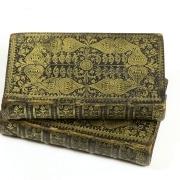Gift Books
One of the hallmarks of 19th century American publishers’ bindings was the gift book. Modeled on European antecedents, the first American gift book appeared in December of 1825, a product of the Philadelphia publishing firm Carey & Lea. Gift books (or “literary annuals”) were compilations of poetry, prose, and illustrations produced on an annual basis. Meant to be given as gifts, as their name implies, they were published in fancy decorated bindings often comprised of novel materials, including embossed morocco, textured cloth, and covers adorned with decorated papers and even mother of pearl.
Publishers of gift books collected some of the best writing and artistic talent of the time. Writers such as Catharine Beecher, Lydia Maria Child, Ralph Waldo Emerson, Hannah Flagg Gould, Nathaniel Hawthorne, Edgar Allan Poe, and John Greenleaf Whittier contributed text, while artists such as portraitists John Cheney and John Sartain contributed engravings. Gift books did not just serve as quasi- “coffee table” books meant to decorate the parlor. They also brought samples of American literature to a much wider reading public.
Other publishers quickly imitated the early efforts of Carey & Lea, recognizing that even with their fancy embellishments, gift books could be rapidly and cheaply produced (in a variety of styles to suit one’s budget) to a guaranteed market year after year. By 1832 there were over a dozen American gift annuals on the market; by 1850, over five dozen. Publishers often recycled illustrative plates and text over the years, sometimes issuing old content under a new title or without a date. The story of gift books is a story of the commodification of reading and of recognizing the value of the book as a material object – judging it by its cover.
The Library Company has one of the premier collections of 19th century American publisher’s bindings and gift books in the country and continues to actively acquire new examples. Our collection includes books bound in publishers’ cloth, embossed morocco, printed and marbled papers, embossed cloth, gilt and inlaid leather, gutta-percha, papier mâché and mother of pearl, velvet, and celluloid. A database of representative publishers’ cloth bindings ranging in date from the mid-1820s to 1900 is available through the link below.
Revised January 2024
Resources
Bibliographies
- Frederick W. Faxon. Literary Annuals and Gift Books. A Bibliography 1823-1903 (Middlesex, England: Private Libraries Association, 1973).
- Bruce Kirkham and John W. Fink. Indices to American Literary Annuals and Gift Books, 1825-1865. (New Haven: Research Publications, 1975).
- Jennifer W. Rosner. “Papier-mâché Bindings: ‘shining in black and gorgeous with pearl and gold.’” In Suave Mechanicals, Vol. 1, edited by Julia Miller. (Ann Arbor: Legacy Press, 2013).
- Michael Sadleir. XIX Century Fiction: A Bibliographic Record Based on His Own Collection (Cambridge, MA: Maurizio Martino, [1992]).
- Michael Tepper. American Gift Books & Literary Annuals: An Annotated Catalog. ([Easton, Maryland: Michael Tepper, 2016]).
- Ralph Thompson. American Literary Annuals & Gift Books 1825-1865 (New York: The H.W. Wilson Company, 1936).
- Edwin Wolf 2nd. From Gothic Windows to Peacocks: American Embossed Leather Bindings, 1825-1855 (Philadelphia: The Library Company of Philadelphia, 1990).
Search Terms
- Blind tooled bindings
- Blocked bindings
- Bookbinding
- Decorated papers
- Embossed bindings
- Embossed cloth bindings
- Gift books
- Gold blocked bindings
- Leather bindings
- Marbled cloth bindings
- Mother-of-pearl bindings
- Painted bindings
- Papier-mache bindings
- Printed cloth bindings
- Publishers’ bindings
- Publishers’ cloth bindings
- Publishers’ paper bindings
- Raised panel bindings
- Raised panel bindings
- Ribbon-embossed cloth bindings
- Signed bindings
- Silk bindings
- Silver blocked bindings
- Sunken panel bindings
- Women former owners
Search Terms by Name of Collectors/Collection
- Todd and Sharon Pattison
- Edwin Wolf 2nd
- Michael Zinman
- Michael Zinman Binding Collection
Exhibitions
Youtube
Selling Antislavery: Abolition and Mass Media in Antebellum America (Book Talk)

